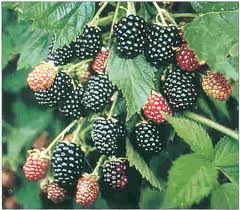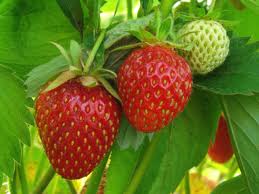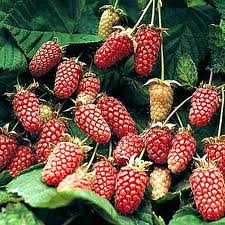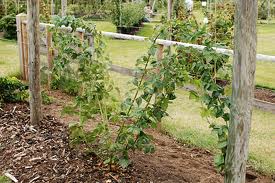Berried Treasures
The day I fell off a donkey and into some blackberry bushes is one I shan’t forget, nor recommend.
 Just what those blackberry bushes were doing right in the middle of a grassy paddock, I don’t know. When the settlers introduced the blackberry to Australia, little did they realise it would be declared a noxious weed in some areas.
In my latest book, The Cook’s Garden, I point out that of all the berries, it is probably the prickliest, so I guess I should count my blessings — apart from numerous scratches, the damage wasn’t too bad, and it hasn’t put me off the berries. The intense flavour of wild blackberries is not to be underestimated.
A day strawberry picking, though, is one I would recommend. I first picked strawberries in Tasmania as a teenager, and I hadn’t seen them growing until then.
Just what those blackberry bushes were doing right in the middle of a grassy paddock, I don’t know. When the settlers introduced the blackberry to Australia, little did they realise it would be declared a noxious weed in some areas.
In my latest book, The Cook’s Garden, I point out that of all the berries, it is probably the prickliest, so I guess I should count my blessings — apart from numerous scratches, the damage wasn’t too bad, and it hasn’t put me off the berries. The intense flavour of wild blackberries is not to be underestimated.
A day strawberry picking, though, is one I would recommend. I first picked strawberries in Tasmania as a teenager, and I hadn’t seen them growing until then.
 We ate as many as we picked. The owner didn’t mind a bit
as he had so many. The sweetness and fragrance of those juicy, freshly picked strawberries has lingered.
That is the ideal way to eat berries — picked fresh from the plant. Strawberries are not difficult to grow.
Apart from their lusciousness, they are pretty, decorative plants which spill over borders and tumble down hills.
They also give a quick return, bearing fruit in less than a year. The ones most often grown are hybrids of various American species, most of which were introduced to Europe during the seventeenth and eighteenth centuries, although some claim the cultivated berries, even at their best, do not equal the wild berries.
The soft fruits that show the next quickest return are raspberries, blackberries and loganberries.
We ate as many as we picked. The owner didn’t mind a bit
as he had so many. The sweetness and fragrance of those juicy, freshly picked strawberries has lingered.
That is the ideal way to eat berries — picked fresh from the plant. Strawberries are not difficult to grow.
Apart from their lusciousness, they are pretty, decorative plants which spill over borders and tumble down hills.
They also give a quick return, bearing fruit in less than a year. The ones most often grown are hybrids of various American species, most of which were introduced to Europe during the seventeenth and eighteenth centuries, although some claim the cultivated berries, even at their best, do not equal the wild berries.
The soft fruits that show the next quickest return are raspberries, blackberries and loganberries.
 Eighteen months after planting the canes you will be able to enjoy the fruit. Raspberries are the most popular, probably because they are the most perfumed and have such an intense flavour. White, red and black varieties exist. Over the years raspberries give bigger crops for the space they occupy than any of the other soft fruits.
The word ‘berry’ can in fact be rather confusing. Strictly speaking, a berry is a fleshy fruit that doesn’t split open and has one or more seeds but no stone (pit). It develops from a single enlarged ovary: grapes, tomatoes, eggplants (aubergines), currants, blueberries and cranberries all fit in this category. The popular understanding of berry is somewhat different and, for our purposes, I have chosen to follow this rather looser definition.
Eighteen months after planting the canes you will be able to enjoy the fruit. Raspberries are the most popular, probably because they are the most perfumed and have such an intense flavour. White, red and black varieties exist. Over the years raspberries give bigger crops for the space they occupy than any of the other soft fruits.
The word ‘berry’ can in fact be rather confusing. Strictly speaking, a berry is a fleshy fruit that doesn’t split open and has one or more seeds but no stone (pit). It develops from a single enlarged ovary: grapes, tomatoes, eggplants (aubergines), currants, blueberries and cranberries all fit in this category. The popular understanding of berry is somewhat different and, for our purposes, I have chosen to follow this rather looser definition.
 Berries are fragile fruits. They don’t travel well, a good reason for planting some in the kitchen garden. However, they do freeze well, an excellent way to retain some for year-round use. Hull them or remove stalks beforehand. Put them on trays each separated from the other and pop into the freezer. When frozen, bundle into plastic freezer bags so they won’t stick together in a lump. Ask your local nursery about the varieties available, and consult the different seed catalogues. That way, you’ll be able to grow some of the more unusual ones yourself.
Berries are fragile fruits. They don’t travel well, a good reason for planting some in the kitchen garden. However, they do freeze well, an excellent way to retain some for year-round use. Hull them or remove stalks beforehand. Put them on trays each separated from the other and pop into the freezer. When frozen, bundle into plastic freezer bags so they won’t stick together in a lump. Ask your local nursery about the varieties available, and consult the different seed catalogues. That way, you’ll be able to grow some of the more unusual ones yourself.


Blackberries

Strawberries

Raspberries

Loganberries

Berry canes
